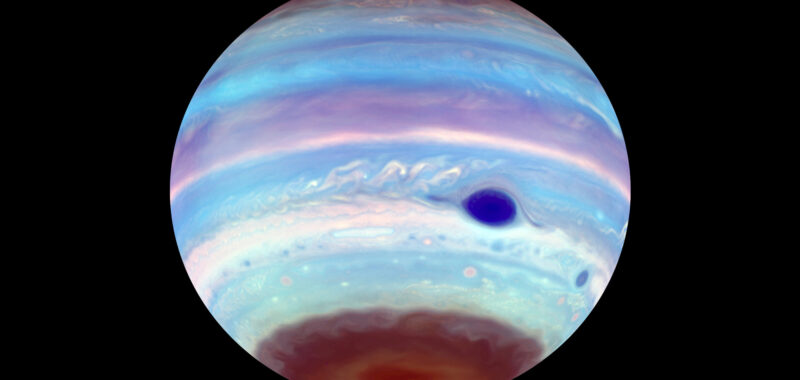Jupiter’s immense size–about 1,000 Earths could fit inside of it–and its swirling and jiggly Great Red Spot typically get most of the attention. Now, the planet’s northern and southern poles have entered the discussion. A team of astronomers have discovered equally large spots at both poles that appear and disappear seemingly at random. The findings are detailed in a study published November 26 in the journal Nature Astronomy.
The dark UV ovals were first detected by NASA’s Hubble Space Telescope during the late 1990s at the north and south poles. During the Cassini spacecraft’s flyby of Jupiter in 2000, it also confirmed these ovals at Jupiter’s north pole, but the ovals did not get a lot of attention from scientists.
Eventually, study co-author University of California, Berkeley undergraduate Troy Tsubota conducted a systematic study of recent Hubble images and found that the ovals were a common feature at the south pole. He counted eight southern UV-dark ovals between 1994 and 2022. In all 25 of Hubble’s maps that show Jupiter’s north pole, Tsubota and Berkeley astronomer and co-author Michael Wong found only two northern UV-dark ovals.
The spots are shaped like ovals that are about the size of our planet and are only visible at ultraviolet wavelengths. They are embedded in layers of stratospheric haze at Jupiter’s top and bottom, similar to the northern and southern lights on Earth. Since the spots absorb more UV light than the surrounding area, they look dark on images taken by Hubble. In annual images of Jupiter taken by Hubble between 2015 and 2022, a dark UV oval appears about 75 percent of the time at its south pole. Dark ovals appear in only one of the eight images taken of the north pole.
According to the team, these dark UV ovals are a hint that some unusual processes are taking place in Jupiter’s strong magnetic field. This field spreads down to the poles and deep into the planet’s atmosphere, much deeper than the magnetic processes that can create auroras here on Earth.
Most of the Hubble images had been captured as part of the Outer Planet Atmospheres Legacy (OPAL) by Amy Simon, a planetary scientist at the NASA Goddard Space Flight Center and a co-author of the study. OPAL astronomers use Hubble to make yearly observations of Jupiter, Saturn, Uranus, and Neptune in order to understand their atmospheric dynamics and evolution over time.
“In the first two months, we realized these OPAL images were like a gold mine, in some sense, and I very quickly was able to construct this analysis pipeline and send all the images through to see what we get,” Tsubota, now a senior at Berkley, said in a statement. “That’s when we realized we could actually do some good science and real data analysis and start talking with collaborators about why these show up.”
The team at Berkeley then consulted two experts on planetary atmospheres to help them determine what might be causing these areas of dense haze: study co-authors Tom Stallard from Northumbria University in the United Kingdom and Xi Zhang at the University of California, Santa Cruz. According to Stallard’s theory, the dark oval is likely stirred from above by a vortex that is created when Jupiter’s magnetic field lines experience friction in two very distant locations. The friction could be happening in the ionosphere–where spinning motion has been detected with ground-based telescopes–and in the sheet of ionized plasma that surrounds its moon Io.
The vortex spins fastest in the ionosphere and weakens as it reaches each deeper layer. Similar to a tornado hitting dusty ground, the deepest extent of the vortex riles up the hazy atmosphere to create the dense spots on the poles. It’s not clear if the mixing dredges up more haze from below or creates additional debris. The team suspects that the ovals form over the course of roughly one month and dissipates in a couple of weeks.
[Related: Jupiter’s Great Red Spot keeps shrinking.]
“The haze in the dark ovals is 50 times thicker than the typical concentration which suggests it likely forms due to swirling vortex dynamics rather than chemical reactions triggered by high-energy particles from the upper atmosphere,” Zhang said in a statement. “Our observations showed that the timing and location of these energetic particles do not correlate with the appearance of the dark ovals.”
According to the team, these results reinforce that OPAL can help us learn how the atmospheric dynamics in the solar system’s giant planets differ from what we know on Earth.
“Studying connections between different atmospheric layers is very important for all planets, whether it’s an exoplanet, Jupiter or Earth,” Wong said in a statement. “We see evidence for a process connecting everything in the entire Jupiter system, from the interior dynamo to the satellites and their plasma torii to the ionosphere to the stratospheric hazes. Finding these examples helps us to understand the planet as a whole.”


